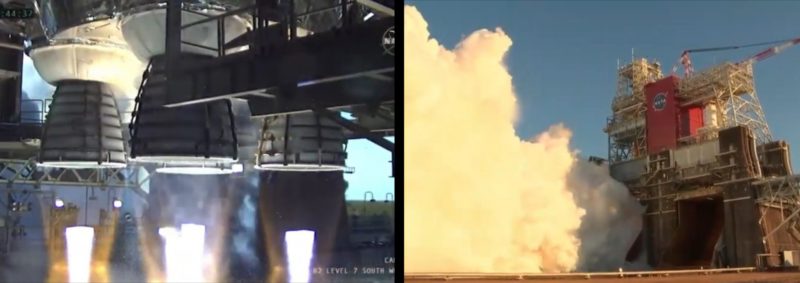
Eighteen years to the day since the last launch of shuttle Columbia, NASA, Boeing and Aerojet Rocketdyne engineers have taken a significant step towards the first launch of the gargantuan Space Launch System (SLS). Four refurbished RS-25 engines—with a combined 1.1 million seconds’ worth of “burn-time” from multiple test-stand runs and no fewer than 25 Space Shuttle missions—roared to life Saturday afternoon on the historic B-2 Test Stand at NASA’s Stennis Space Center (SSC) in Bay St. Louis, Miss.
On hand was STS-118 astronaut Tracy Caldwell Dyson, whose flight aboard shuttle Endeavour in August 2007 was powered to orbit by one of the powerful engines being tested today. However, for reasons which presently remain unclear, an issue related to the number 4 engine forced an automated premature shutdown a little over a minute into the hoped-for 8-minute burn. It remains to be seen if a second Hot Fire Test will be necessary before the Core Stage ships from Stennis to the Kennedy Space Center (KSC) in Florida,
“All four RS-25 engines ignited successfully, but the test was stopped early after about a minute,” said NASA in a blog update following the test. “At this point, the test was fully automated. During the firing, the onboard software acted appropriately and initiated a safe shutdown of the engines. During the test, the propellant tanks were pressurized, and this data will be valuable as the team plans the path forward. In coming days, engineers will continue to analyze data and will inspect the core stage and its four RS-25 engines to determine the next steps.”
“You could hear on the communications a FID on engine 4, which is our terminology for a failure identification, shortly followed by a MCF, which is a Major Component Failure. Any parameter that went ary on the engine can send that failure ID, but at the time we did have four good engines running at 109%,” said SLS Program Manager John Honeycutt. “When we got to main stage when we started the engines, part of the plan was to throttle back to 95% and then throttle back up to 109%, and at the same time we’re running the gimbal profile for all 4 engines. So there’s a lot of dynamics going on at that point in time.”
We did see a bit of a flash come from the interface between the thermal protection blanket and engine 4 at the time we initiated the gimbal,” added Honeycutt. “At that point in time, to the best of my knowledge at this time, the engine controller sent the data to the core stage controller to shut the vehicle down.”
“We accomplished a lot today. We got the vehicle loaded, we got our pressurization system rung out, we got the engines conditioned and got roughly 60 seconds of time on the RS-25s.”
Today’s Hot Fire Test was the eighth and final test of the year-long “Green Run” campaign to wring out the functional and operational systems of the 212-foot-tall (64.6-meter) SLS Core Stage. It was hoped that today’s Hot Fire Test would run for as much as 485 seconds, mimicking as closely as possible the eight-minute-long burn of their four RS-25s on a real SLS mission. These engines will ignite again, hopefully later this fall, from Pad 39B at the Kennedy Space Center (KSC) in Florida for the real thing: the first voyage of a human-rated vehicle to lunar distance since December 1972.
Countdown operations formally got underway last Thursday with the initial power-up of avionics on the Core Stage. Early Saturday, the test team conducted a pre-test briefing at the Test Control Center in the B Test Complex and issued a definitive “Go” to press ahead with fueling the Core Stage with 733,000 gallons (3.3 million liters) of cryogenic liquid oxygen and hydrogen propellants.
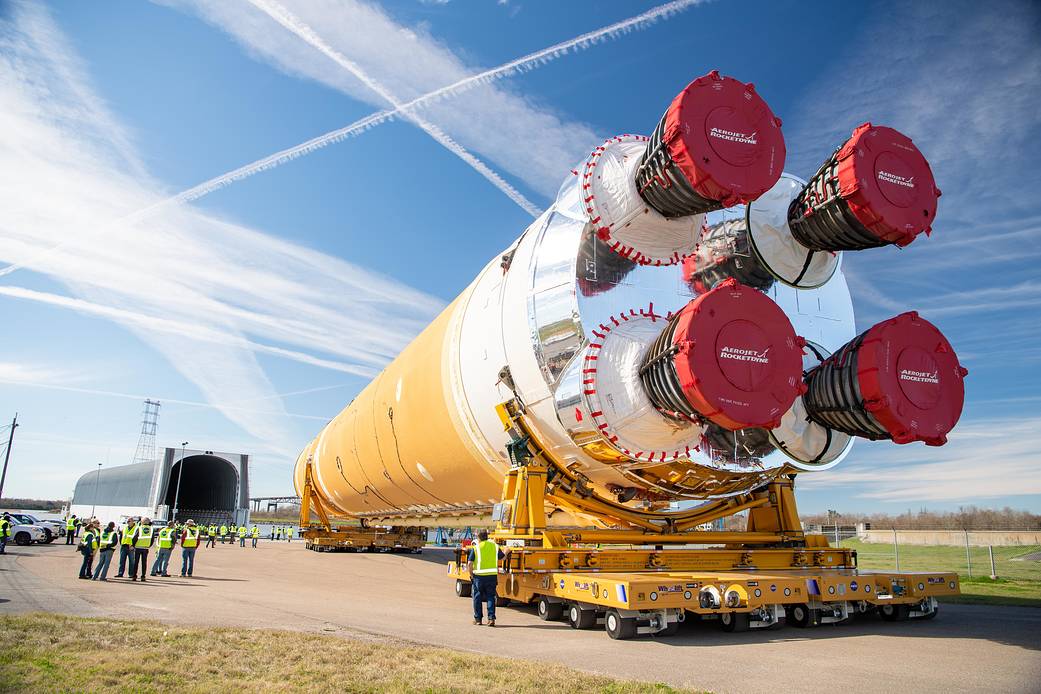
Fueling concluded early Saturday afternoon, with Stennis teams reportedly running an hour of schedule, allowing for the advancement of the start of the two-hour test “window” from 5 p.m. EST to 4 p.m. EST. However, with an acute awareness that this was a “test”, rather than a “demonstration”, the minutes ticked by with agonising slowness.
After entering the final phase of the countdown at T-10 minutes, the final seconds of the countdown mirrored closely the last phase of a Space Shuttle launch, with the four engines igniting at roughly 120-millisecond intervals, commanded at about T-6.6 seconds. Ignition occurred at 5:27 p.m. EST.
And in a manner also not dissimilar to shuttle operations, the ignition of the liquid-fueled engines was accompanied by the characteristic “Mach diamonds” as exhaust gases exited their nozzles at supersonic velocities, accompanied by billowing clouds of steam. But there the similarities ended. Whereas the shuttle-era RS-25s burned to a maximum power level of 104.5 percent of rated performance, those of the SLS Core Stage will typically ramp up to 109 percent at T-0.
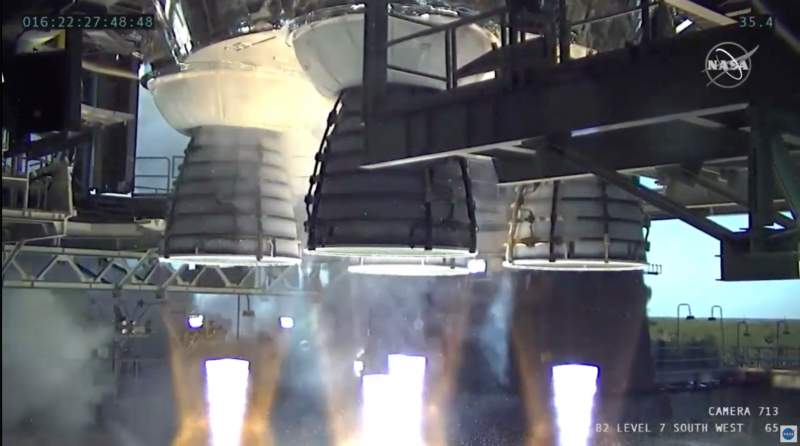
The engines burned nominally for a little over a minute, ahead of a premature shutdown.
Approximately one minute into today’s Hot Fire Test, to simulate the necessary throttle-down of the engines at the point of “Max Q”—the point of maximum aerodynamic stress on the SLS—all four RS-25s were commanded back to 95 percent of rated performance.
Today’s Hot Fire Test marked the culmination in a year-long campaign to put the Core Stage through the eight-step Green Run—five “functional” checks of various rocket systems, followed by three “operational” tests to demonstrate countdown, fueling and hot-fire activities—before it is transported to KSC for final processing and integration with the rest of the Artemis-1 mission hardware. Throughout the challenging dozen months of 2020, the Core Stage resided within the confines of the B-2 Test Stand at NASA’s Stennis Space Center (SSC) in Bay St. Louis, Miss., as the eight functional and operational tests in support of the Green Run campaign got underway.
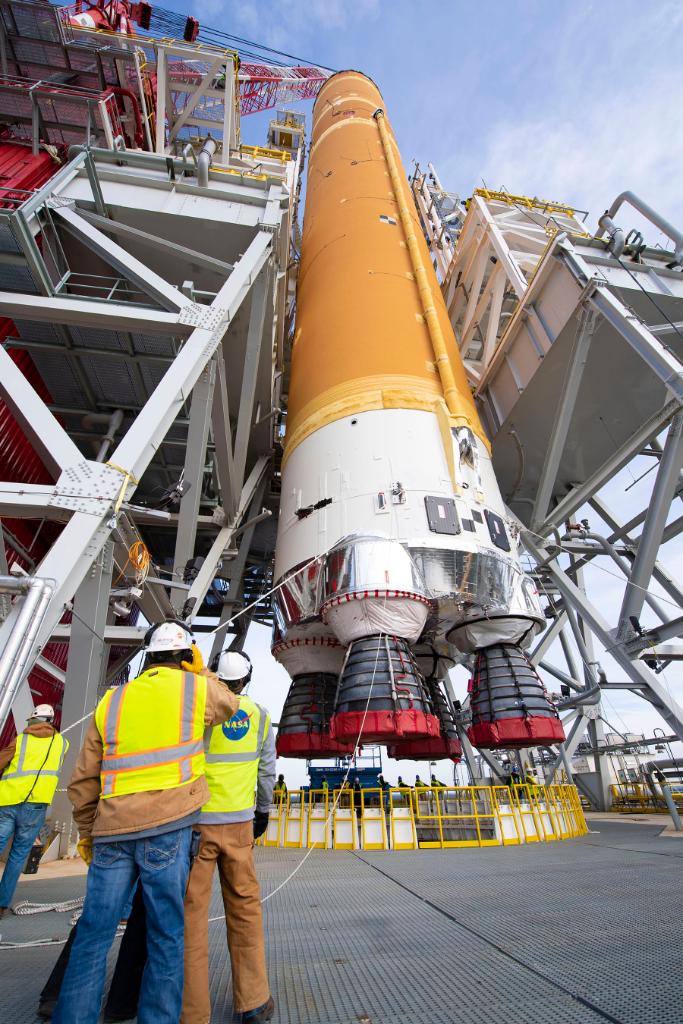
The Core Stage arrived at Stennis from NASA’s Michoud Assembly Facility (MAF) in New Orleans, La., aboard the Pegasus barge in the second week of last January—almost exactly one year ago—whereupon it was hoisted into the cavernous expanses of the B-2 facility.
Previously used for qualification test-firings of the RS-25 in its earlier incarnation as the Space Shuttle Main Engine (SSME), together with the Common Booster Core (CBC) for the United Launch Alliance (ULA) Delta IV and the S-IC first-stage of the mighty Saturn V, the stand has a long and chequered history which extends back almost five decades.
Within days of its arrival, the Core Stage was put through the first Green Run test to begin wringing out its systems under functional and operational conditions. The “Modal Test” utilized mechanized “shakers” to impart dynamic forces as a means of identifying bending modes to help validate vehicle models to operate the great rocket’s Guidance, Navigation and Control (GNC) systems.
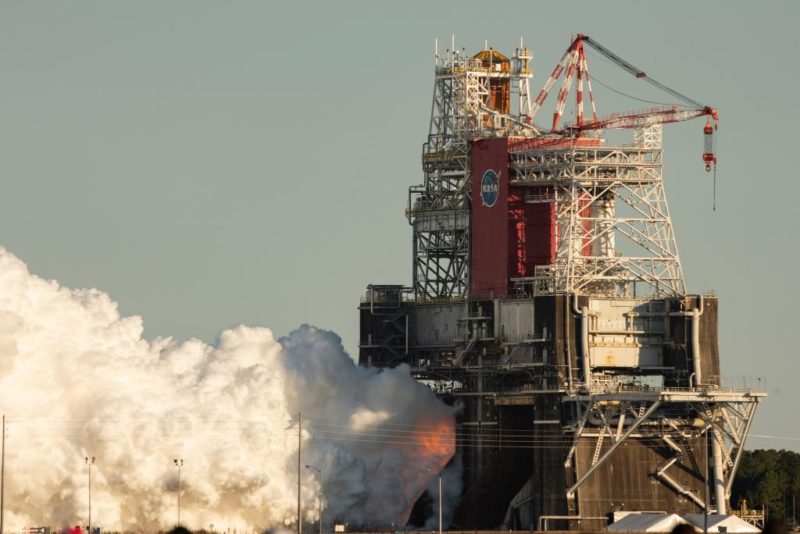
However, the arrival of COVID-19 pushed Stennis into a “Level Four” posture on the scale of NASA’s pandemic response framework in March, with only essential personnel whose duties pertained to the safety and security of the center permitted to remain on site.
When crews returned to work in mid-May, the Core Stage systems were reactivated and checked out, both for the test stand the test control center. At the end of June, the second Green Run test—the “Avionics Test”—was successfully completed. The avionics, including the flight control computers and electronics, as well as a multitude of sensors which gather flight data and monitor the health of the Core Stage in flight, were powered-up and checked out.
The “Fail-Safes Test” of the Core Stage’s safety systems concluded in early July, followed by the “Propulsion Test” in early August to check for leaks and evaluate command-and-control operations for the Main Propulsion System (MPS) elements which directly interface with the four RS-25 engines.
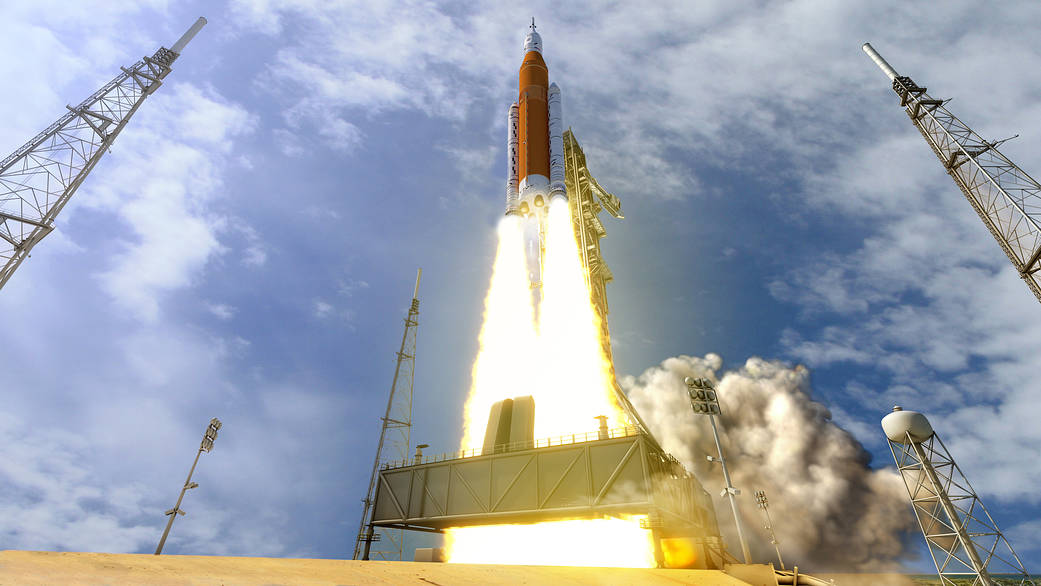
But in addition to COVID-19, Mother Nature also imparted her own pressures on the progress of the Green Run. August brought a pair of exceptionally powerful natural predators in the menacing forms of Hurricanes Marco and Laura, which devastated the Caribbean Sea and threatened the Gulf Coast.
Work was temporarily suspended for a few days in late August as both the B-2 stand and the Core Stage were secured until the storms passed. The fifth test concluded early in September and formed the final “functional” test, devoted to evaluating the Core Stage’s Thrust Vector Control (TVC) and hydraulics.
With the completion of the five functional tests, the final three tests were considered “operational” in nature, since all were geared towards an all-up countdown, fueling and test-firing of the four RS-25 engines for 485 seconds, mimicking a full mission duration as closely as practicable on the ground. However, the weather was not quite done with the Green Run, as even the countdown test was delayed a few days in response to the threat of Hurricane Sally.
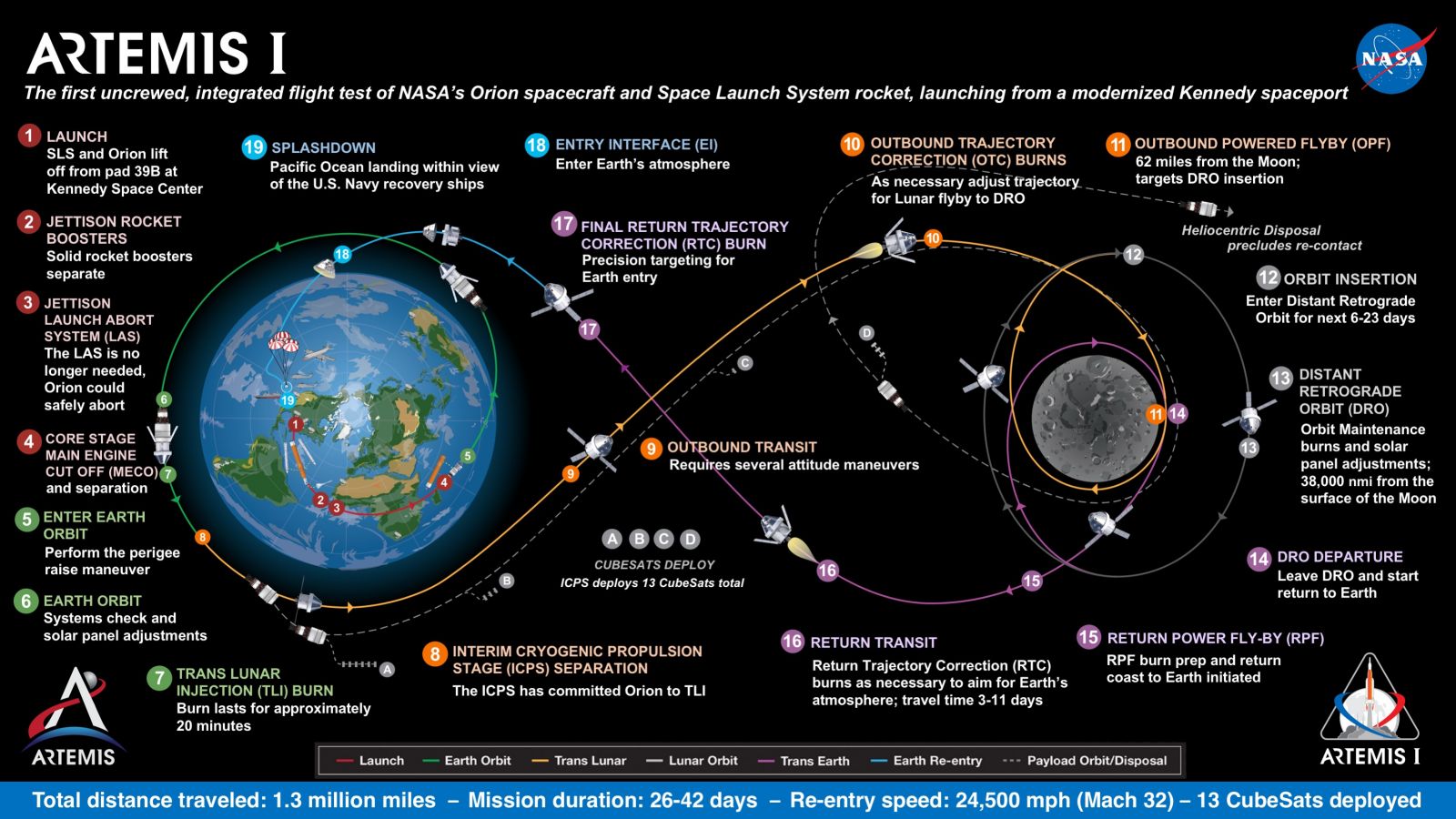
It was finally completed in early October, with hopes that fueling the Core Stage with 733,000 gallons (3.3 million liters)—six barge-loads—of liquid oxygen and hydrogen for the Wet Dress Rehearsal (WDR) and Hot Fire Test might occur before year’s end.
By the end of October, efforts had again been temporarily suspended in response to the ravages of Hurricane Zeta, which caused some damage to buildings and roofs at Stennis but from which the B-2 Test Stand and the Core Stage emerged unscathed. During the pause of on-site work, engineers identified inconsistent performance from one of eight pre-valves responsible for supplying liquid hydrogen to the RS-25 engines.
The cause was traced to a faulty clutch and was repaired and satisfactorily tested in mid-November. This allowed Green Run personnel to press ahead with plans for the seventh test—the WDR—as soon as 7 December, with hopes of a Hot Fire Test during the week of the 21st.
A test readiness review in early December verified that all systems were in a state of readiness for the WDR. On the morning of the 5th, the cryogenic tanking process got underway. However, it became apparent that the liquid oxygen temperatures were warmer than anticipated and the NASA/Boeing team elected to pause the WDR to take a closer look at the test data before committing to pumping the full propellant load into the Core Stage’s tanks.
“After an integrated assessment of the Core Stage and the facility,” NASA noted on 10 December, “the team identified processes and equipment that could be modified to keep the liquid oxygen at the proper temperature during delivery to the stage.”
Finally, a week before Christmas, the Core Stage was powered up for a second attempt to execute the WDR. On 20 December, the tanks were loaded with liquid oxygen and hydrogen propellants, with initial indications pointing to a satisfactory performance of the hardware. Part of the test was to simulate the final phase of an SLS launch countdown, leading up to 33 seconds before the ignition of the RS-25 engines.
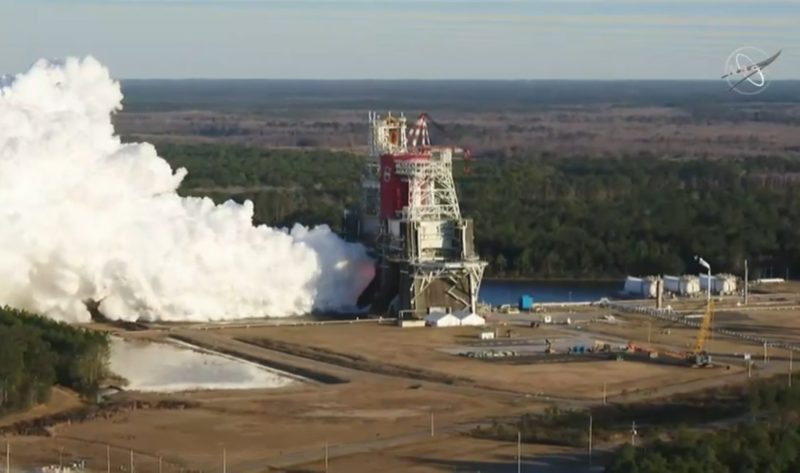
However, the test ended a few seconds shy of its planned countdown duration due to a timing issue associated with a valve closure. “Subsequent analysis of the data determined the valve’s predicted closure was off by a fraction of a second,” NASA noted on 5 January, “and the hardware, software and stage controller all performed properly to stop the test.”
Last week, with this timing issue corrected, the space agency announced its preparedness to proceed with the Hot Fire Test, no sooner than Sunday, 17 January. But following a test readiness review, it was revealed that the critical test would move to the left, with teams targeting Saturday instead.
– Written by Ben Evans and Mike Killian
.
.
FOLLOW AmericaSpace on Facebook and Twitter!
.
.
Missions » SLS »



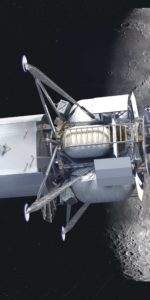
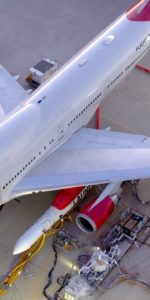
I hate to imagine what Kamala Harris and her squad of regressive progressives must have thought about this prime time flop.
The best takeaway from it is that SLS remains the only game in town when it comes to sending NASA’s finest beyond earth orbit.
I really support what SpaceX is trying to do with Starship but the fact is NASA has not awarded funding towards it development. And neither has the U.S. military in spite of Elon’s best attempts at persuading them otherwise during the Trump presidency.
I now appreciate the foresight soon-to-be former NASA administrator Bridenstine for impressing upon the Artemis programme to land the first woman and next man on the Moon. He had to appeal to the identity politics obssessed Democrats — now in total control of both the White House and U.S. Congress — weeks and months before election day 2020.
The unsuccessful Green Run test perfectly summed up the mess NASA human spaceflight faces, but the programme may be too far advanced to be cancelled. We shall soon see.
It wouldn’t be the only game in town with on orbit refueling. The FH could do the job with that one development. Also, beware of the sunk cost fallacy regarding SLS. It is how much more to get it to work against how much for a competing concept.